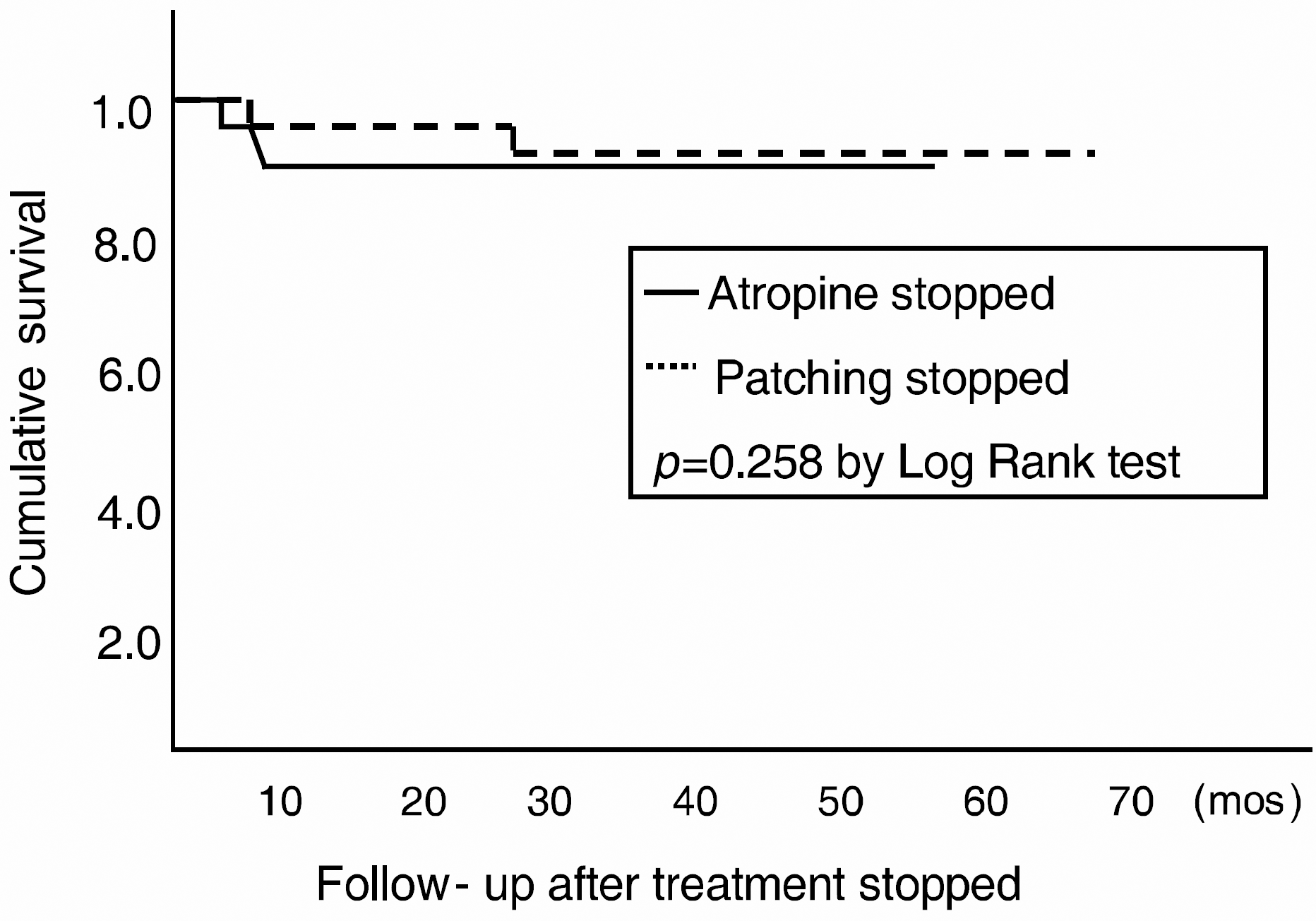Abstract
Purpose
To identify the clinical features with recurrence of amblyopia after cessation of amblyopic treatment.
Methods
Amblyopic children followed up at least 1 year after successful treatment were evaluated. A recurrence of amblyopia was defined as a reduction of more than 2 levels in visual acuity (VA) of the amblyopic eye after cessation of treatment. The age and VA of the amblyopic eye at the start and during follow-up, type of amblyopia, type and duration of treatment, weaning and stereopsis on cessation of treatment were analyzed.
Results
Amblyopia recurred in 5 out of 82 patients with successful treatment, and the period of recurrence varied from 7 to 31 months after cessation of treatment. Two out of 5 recurred patients had only patching therapy and the other 3 patients had atropine penalization after patching therapy. The weaning was performed in the 5 recurred patients at cessation of treatment. There was no remarkable clinical factor associated with recurrence of amblyopia.
Go to : 
References
1. Ching FC, Parks MM, Friendly DS. Practical management of amblyopia. J Pediatr Ophthalmol Strabismus. 1986; 23:12–6.

2. Scott WE, Dickey CF. Stability of visual acuity in amblyopic patients after visual maturity. Graefes Arch Clin Exp Ophthalmol. 1988; 226:154–7.

3. Leiba H, Shimshoni M, Oliver M, et al. Long-term follow up of occlusion therapy in amblyopia. Ophthalmology. 2001; 108:1552–5.
4. Ohlsson J, Baumann M, Sjostrand J, Abranhamsson M. Long term visual outcome in amblyopia treatment. Br J Ophthalmol. 2002; 86:1148–51.

5. Gregersen E, Rindziunski E. “Conventional” occlusion in the treatment of squint amblyopia. A ten year follow-up. Acta Ophthalmol. 1965; 43:462–74.
6. Bhola R, Keech RV, Kutschke P, et al. Recurrence of amblyopia after occlusion therapy. Ophthalmology. 2006; 113:2097–100.

7. Holmes JM, Melia M, Bradfield YS, et al. Factors associated with recurrence of amblyopia on cessation of patching. Ophthalmology. 2007; 114:1427–32.

8. Tacagni DJ, Stewart CE, Moseley MJ, Fielder AR. Factors affecting the stability of visual function following cessation of occlusion therapy for amblyopia. Graefes Arch Clin Exp Ophthalmol. 2007; 245:811–6.

9. Levartovsky S, Oliver M, Gottesman N, Shimshoni M. Factors affecting long term results of successfully treated amblyopia: initial visual acuity and type of amblypoia. Br J Ophthalmol. 1995; 79:225–8.
10. Levartovsky S, Oliver M, Gottesman N, Shimshoni M. Factors affecting long term results of successfully treated amblyopia: age at be-ginning of treatment and age at cessation of monitoring. J Pediatr Ophthalmol Strabismus. 1992; 29:219–23.
11. Levartovsky S, Oliver M, Gottesman N, Shimshoni M. Long term effect of hypermetropic anisometropia on the visual acuity of treated amblyopic eyes. Br J Ophthalmol. 1998; 82:55–8.

12. Flynn JT, Woodruff , Thompson JR, et al. The therapy of amblyopia: an analysis comparing the results of amblyopia therapy utilizing two pooled data sets. Trans Am Ophthalmol Soc. 1999; 97:373–90.
13. Holmes JM, Beck RW, Kraker RT, et al. Risk of amblyopia recurrence after cessation of treatment. J AAPOS. 2004; 8:420–8.
14. Yu DK, Choi MY. The efficacy of intermittent atropine penalization in amblyopic children who have failed patching therapy. J Korean Ophthalmol Soc. 2005; 46:1167–74.
15. Foley-Nolan A, McCann A, O'keefe M. Atropine penalisation versus occlusion as the primary treatment for amblyopia. Br J Ophthalmol. 1997; 81:54–7.

16. Nilsson J, Baumann M, Sjostrand J. Strabismus might be a risk factor for amblyopia. J AAPOS. 2007; 11:240–2.
Go to : 
 | Figure 1.Kaplan-Meier curve showing cumulative probability of recurrence of amblyopia. Three patients who had stopped atropine penalization developed recurrence at 7.0, 13.3, 13.8 months and two who had stopped patching at 12.3, 30.1 months. |
Table 1.
Clinical characteristics of patients with recurrence of amblyopia from previous viewpoint as risk factor of recurrence
Table 2.
Demographic characteristics
| Atropine stopped N=33, n (%) | Patching stopped N=49, n (%) | p-value | |
|---|---|---|---|
| Gender | 0.466* | ||
| Male | 17 (52) | 20 (41) | |
| Female | 16 (48) | 29 (59) | |
| Age (years) | 6.2±1.8 | 5.3±1.9 | 0.061† |
| < 3 | 0 (0) | 2 (4) | |
| 3 ≤ < 5 | 10 (30) | 19 (39) | |
| 5 ≤ < 7 | 14 (42) | 21 (43) | 0.066* |
| 7 ≤ < 9 | 7 (21) | 6 (12) | |
| 9 ≤ < 11 | 2 (7) | 1 (2) |
Table 3.
Cause of amblyopia
Table 4.
Inter-eye difference at treatment of amblyopia and cessation of treatment
| Intereye difference (LogMAR levels) | Atropine stopped N=33 | Patching stopped N=49 | p-value |
|---|---|---|---|
| At treatment of amblyopia | 0.430* | ||
| 2∼3 | 15 | 20 | |
| 4∼5 | 9 | 20 | |
| 6∼7 | 4 | 5 | |
| 8∼9 | 5 | 4 | |
| At cessation of treatment | 0.536* | ||
| 0 | 17 | 32 | |
| 1 | 16 | 15 | |
| 2 | 0 | 2 |
Table 5.
Duration of treatment
| (months) | Atropine stopped N=33, n (%) | Patching stopped N=49, n (%) | p-value |
|---|---|---|---|
| 3 ≤ < 6 | 11 (33) | 9 (18) | |
| 6 ≤ < 9 | 11 (33) | 9 (18) | |
| 9 ≤ < 12 | 4 (12) | 4 (8) | 0.536* |
| 12 ≤ < 15 | 2 (6) | 4 (8) | |
| 15 ≤ < 18 | 2 (6) | 4 (8) | |
| 18 ≤ | 3 (10) | 19 (40) | |
| Mean± SD | 8.2±5.3 | 17.6±13.6 | <0.01* |




 PDF
PDF ePub
ePub Citation
Citation Print
Print


 XML Download
XML Download